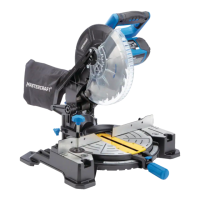10 11
model no. 055-6762-0 | contact us 1-800-689-9928
SAFETY GUIDELINES
KEY PARTS DIAGRAM
condition that may affect the tool’s operation. A guard or other part that is damaged should be properly
repaired or replaced by a qualified person.
• Save these instructions. Refer to them frequently and use them to instruct others who may
use this tool. If someone borrows this tool, make sure he or she has these instructions.
GLOSSARY OF WOODWORKING TERMS
• Spindle: The revolving shaft on which a blade or cutting tool is mounted.
• Spindle Lock: Allows the user to stop the blade from rotating while tightening or loosening the blade
screw during blade replacement or removal.
• Bevel Cut: A cutting operation made with the blade at any angle other than 90° to the mitre table.
• Chamfer Cut: A cut removing a wedge from a block of wood so the end (or part of the end) is angled
other than at 90°.
• Compound Mitre Cut: A cut made using both a mitre angle and a bevel angle at the same time.
• Crosscut: A cutting operation made across the grain of the workpiece.
• Freehand Cut: Performing a cut without using a fence, mitre gauge, fixture, work clamp, or other
proper device to keep the workpiece from twisting or moving during the cut. Do not perform any
operation freehand. Use a clamp or vice wherever possible.
• Kerf: The material removed by the blade in a through cut or the slot produced by the blade in a non-
through or partial cut.
• Kickback: A hazard that can occur when the blade binds or stalls, throwing the workpiece back
toward the operator.
• Mitre Cut: A cutting operation made with the blade at any angle other than 90° to the fence.
• No-Hands Zone: The area between the marked lines on the left and right side of the mitre table base.
This zone is identified by No-Hands Zone symbols inside the lines marked on the mitre table base.
• Non-through Cut: Any cutting operation where the blade does not extend completely through the
thickness of the workpiece.
• Revolutions Per Minute (RPM): The number of turns completed by a spinning object in one minute.
• Saw Blade Path: The area over, under, behind or in front of the blade, as it applies to the workpiece;
the area that will be or has been cut by the blade.
• Set: The distance that the saw blade tooth is bent (or set) outward from the face of the blade.
• Throat plate: A plate inserted in the mitre saw table that allows for blade clearance.
• Through Sawing: Any cutting operation where the blade extends completely through the thickness of
the workpiece.
• Workpiece or Material: The item on which the cutting operation is being done. The surfaces of a
workpiece are commonly referred to as faces, ends and edges.
NOTE:
Before attempting to use your saw, familiarize yourself with all of the operating features and
safety requirements.
No. Description
1 Switch handle
2 On/Off trigger switch
3 Upper blade guard
4 Lower blade guard
5 Base
6 Table insert
7 Mitre handle
8 Mitre stop locking lever
No. Description
9 Mitre scale
10 Positive mitre stop
11 Mounting hole
12 Handhold for transportation
13 Hex wrench
14 Fence
15 Dust bag
WARNING!
Carefully remove the tool and any accessories from the box. Make sure that all items listed in
the packing list are included. Inspect the tool carefully to make sure that no breakage or damage
occurred during shipping.
WARNING!
Do not discard the packing material until you have carefully inspected and satisfactorily operated
tool.
2
1
3
4
5
6
7
8
9
12
13
11
10
15
14

